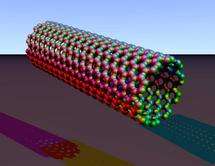Chemists measure chilli sauce hotness with nanotubes

Oxford chemists have found a way of using carbon nanotubes to judge the heat of chilli sauces. The technology might soon be available commercially as a cheap, disposable sensor for use in the food industry.
Professor Richard Compton and his team at Oxford University have developed a sensitive technique to measure the levels of capsaicinoids, the substances that make chillies hot, in samples of chilli sauce. They report their findings in the Royal Society of Chemistry journal The Analyst.
The current industry procedure is to use a panel of taste-testers, and is highly subjective. Compton’s new method unambiguously determines the precise amount of capsaicinoids, and is not only quicker and cheaper than taste-testers but more reliable for purposes of food standards; tests could be rapidly carried out on the production line.They tested a range of chilli sauces, from the mild 'Tabasco Green Pepper' sauce to 'Mad Dog’s Revenge', which sports an extensive health warning and liability disclaimer.
The well-established Scoville method – currently the industry standard – involves diluting a sample until five trained taste testers cannot detect any heat from the chilli. The number of dilutions is called the Scoville rating; the relatively mild Jalapeño ranges from around 2,500-8,000, whereas the hottest chilli in the world, the 'Naga Jolokia', has a rating of 1,000,000. High performance liquid chromatography (HPLC) can also be used but this requires bulky, expensive equipment and detailed analysis of the capsaicinoids.
In Compton’s method, the capsaicinoids are adsorbed onto multi-walled carbon nanotube (MWCNT) electrodes. The team measures the current change as the capsaicinoids are oxidised by an electrochemical reaction, and this reading can be translated into Scoville units. The technique is called adsorptive stripping voltammetry (ASV), and is a relatively simple electrochemical method.
Professor Compton said: ‘ASV is a fantastic detection technique for capsaicinoids because it’s so simple - it integrates over all of the heat creating constituents because all of the capsaicinoids have essentially the same electrochemical response.’
Professor Compton has applied for a patent on the technology, and Oxford University’s technology transfer subsidiary ISIS Innovation is actively seeking backers to commercialise the technique.
Source: Oxford University





















